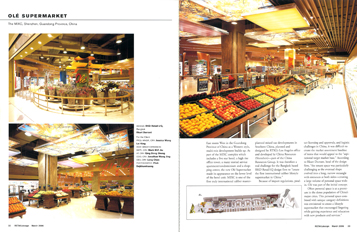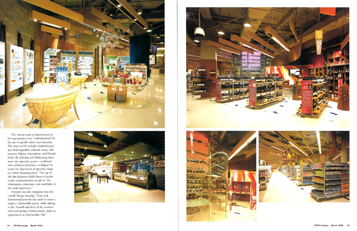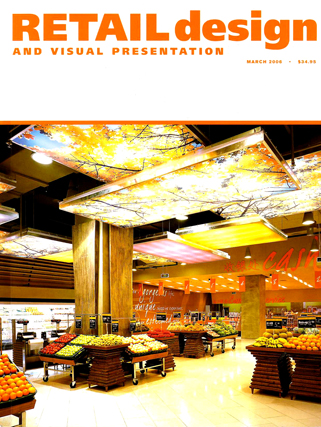Ole’ supermarket G1
East meets West in the Guandong Province of China as a Western style, multi-mix development builds up. As part of the MIXC complex which includes a five star hotel, a high rise office tower, a many storied service apartment/condominium and a shopping center, the new Olé Supermarket made its appearance on the lower level of the hotel unit. MIXC is one of the first truly international caliber master planned mixed use developments in Southern China, planned and designed by RTKL’s Los Angeles office and developed by China Resources (Shenzhen)—part of the China Resources Group. It was therefore a real challenge for the Bangkok based rkd retail/iQ design firm to “create the first international caliber lifestyle supermarket in China.   |
 Because of import regulations, product licensing and approvals, and logistic challenges in China, it was difficult to create the market assortment baseline of items that would appeal to the “aspirational target market base.” According to RKurt Durrant, head of the design firm, “the tenant space was particularly challenging as the eventual shape evolved into a long, narrow rectangle with entrances at both sides—creating a large volume of personal space with in. Olé was part of the initial concept. Often personal space is at a premium in the dense population of China’s major cities. This personal space combined with unique category definitions was envisioned to create a lifestyle supermarket that encouraged lingering while gaining experience and education with new products and services.” |
The various areas or departments in the supermarket were “individualized” by the use of specific colors and materials. The areas in Olé include: health/beauty/spa, fruit/vegetable, seafood, meats, delicatessen, bakery, wine/spirits, and lifestyle food. By defining and delineating these areas into specialty spaces—combined with architectural forms—it helped “to create the impression of specialty shops on a food shopping street.” On top of this the designers added layers of multimedia communication to add to “the information, education, and credibility of the retail experience.” Artwork was also integrated into the overall “design layering.” Print and dimensional artwork was used to create a respite, a pleasurable pause, while adding to the “overall taste level of the environment and giving Chinese artistic styles an opportunity to help localize Olé.” |
|
link to retail design international>